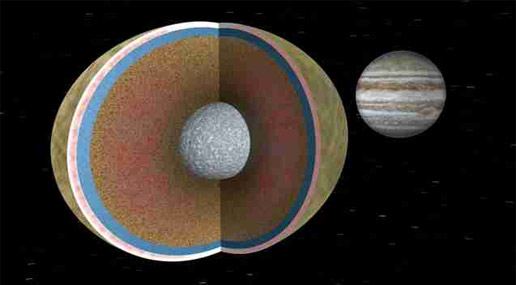Jupiter probably does not have a solid core. Jupiter’s core contains some rock and hydrogen metals. Scientists can not be 100 percent certain if deep within the planet there is a solid core or not, but based on gravitational measurements compared with Earth’s, the best educated guesses possible based on those measurements say there is no solid core. Those measurements make them think that the core is a thick, super hot soup.
Jupiter’s composition is more of a mystery than anything else. The accepted theory holds that it consists of a dense core made of a mixture of elements, the core is thought to be surrounded by a layer of liquid metallic hydrogen and helium, then the outer layer is to be dominated by molecular hydrogen. The core is often speculated to be rocky. It wasn’t until 1997 that the existence of the core was even theorized. Gravitational measurements were taken, indicating a mass in the neighborhood of 12 to 45 times the Earth’s mass, so the proposed core accounts for about 3–15% of the total mass of the planet. The presence of a planetary core follows accepted knowledge of planetary formation. According to this knowledge base, Jupiter would have had to form a rocky or icy core with enough mass in order to capture such a high percentage of gasses from the early solar nebula. Scientists admit that the planet may lack a core at this time due to the high heat and as hot liquid metallic hydrogen mixed with the molten core, carrying it to higher levels of the planet’s interior.
The layer of dense molten hydrogen metal extends to the 78th percentile of the planet’s radius. Just above the layer of metallic hydrogen is an interior atmosphere of hydrogen. The hydrogen at this point is at a temperature where there are no distinct liquid and gas phases, so the hydrogen is in a supercritical fluid state. The temperature and pressure increase steadily toward the core. In the region where hydrogen becomes metallic, the temperatures are thought to be up to 10,000 K and the pressure is 200GPa. The temperature at the core boundary is estimated to be 36,000 K and the pressure is believed to be 3,000 to 4,500 Gpa.
Since very little is known about the composition of Jupiter’s core or even if it still exists, the JUNO space mission was launched on August of 2011. It should arrive in orbit around Jupiter in 2016. The purpose of the mission is to orbit the poles and clear up some of the mysteries surrounding the planet and the entire Jovian system.
We’ve written several articles about planetary cores for Universe Today. Here’s an article about the Earth’s core, and here’s an article about the core of Mercury.
If you’d like more information on Jupiter, check out Hubblesite’s News Releases about Jupiter, and here’s a link to NASA’s Solar System Exploration Guide to Jupiter.
We’ve also recorded an episode of Astronomy Cast all about Jupiter. Listen here, Episode 56: Jupiter.
Source: NASA

